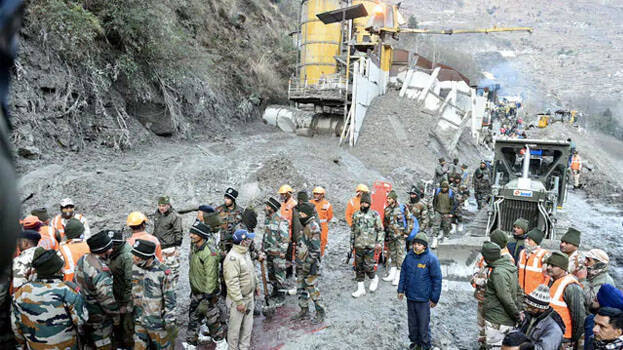18 FEBRUARY 2021 /
GLACIER BURST IN UTTARAKHAND /
Rescue and relief operations are continuing in Chamoli of Uttarakhand where a glacier burst led to massive floods that devastated many.
The Rishiganga Hydropower project near Joshimath was washed away and NTPC hydro project on the Dhauliganga River was partially damaged due to flood.
Many bridges were damaged and relief work and rescue operations are continuing with the help of State Disaster Response Force (SDRF), National Disaster Response Force(NDRF), Indo Tibetan Border Police Force ( ITBP) and Defence Forces. The Indian Air Force has deployed its choppers for medical and rescue operations in this area.
The Tapovan Power Projects of NTPC located five kilometres down to the main disaster site were also damaged.
More than thirty people are feared trapped in a tunnel at the Tapovan-Vishnugad Project.
Uttarakhand Chief Minister Trivendra Singh Rawat took stock of the situation and assured all assistance in rescue operations.
The state government has issued helpline numbers – 1070 / 9557444486.
A Team of DRDO’s Snow and Avalanche Study Establishment Scientists and ISRO Scientists were reached Joshimath for conducting comprehensive study of the disaster.
Scientists are of the view that a glacial lake in Nanda Devi burst and flooded the Dhauli Ganga and other rivers in the Alakananda river system.
There is another belief that a broken mountain peak falling on a glacier might be the reason for the avalanche and floods.
Glaciers are layers of compressed snow and due to seismic activity and water pressure, glaciers burst and cause floods downstream. There are many glaciers across the Himalayas and have potential to cause heavy flooding.
It is very clear that the central government and the Uttarakhand government couldn’t ignore the warnings of the environmentalists against many hydroelectric projects and dams in the ecologically sensitive Himalayas.
Alarms have been raised repeatedly after the earthquake in 1991 and after the 2013 floods that devastated Kedarnath.
The Chopra Committee Report of 2014 clearly brings the facts that the dams are the main reasons for the disaster such as floods. The Chopra Committee was formed in 2013 as per the directions of the Supreme Court to constitute an expert body to assess whether dams exacerbated the 2013 floods in Uttarakhand where more than 4000 people were killed in the Kedarnath Valley.
The environmentalist Ravi Chopra headed the Committee along with geologists and biodiversity experts and submitted the report. The Expert Group recommended that “at least 23 hydropower projects should be dropped and the hydropower projects played a significant role in the Uttarakhand disaster and that there is urgent need to improve the environment governance of hydropower projects”.
Chopra Committee also recommends:
“Since the Himalaya are our vital source of growth and abundance, National Himalayan Policy needs to be urgently created and implemented. Therefore, the Expert Body strongly recommends that a detailed study of the impacts of hydropower projects in terms of deforestation/tunneling /blasting/reservoir formation on the hydrogeology of the area should be carried out”.
The Report carries a clear picture that dams constructed in the areas are the cause of damage and the Committee suggested that the dam projects proposed may be reviewed or be cancelled.
But the environmental norms and guidelines for dam construction continue to be flouted in the country.
In terms of earthquake risk also, Uttarakhand lies in Seismic Zone-IV and Seismic Zone-V (severe & very severe intensity).
It is high time to rethink our heavily invested dam projects in the Himalayan region and study all the river projects and their impacts on our ecology and environment.
The death toll rose to 58 and nearly 179 persons are still missing in the flood and rescue operations are continuing in Chamoli.
Rescue officials are monitoring the size of a lake that has been formed on the upper reaches of Rishiganga and the lake is estimated to be 350 metres long.


